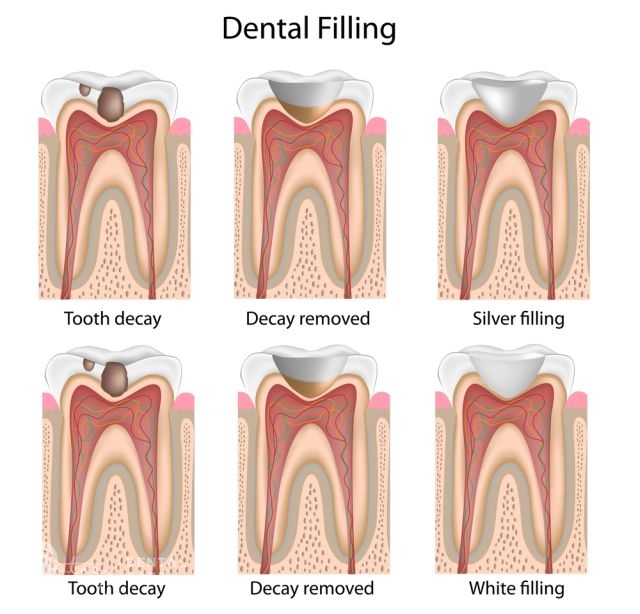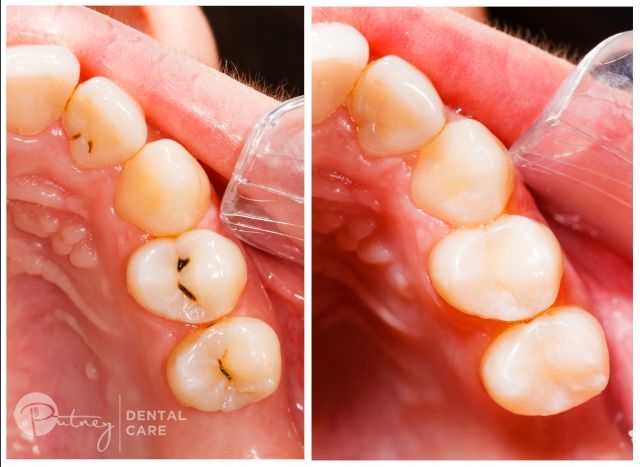
Dental Filling
One of the most common forms of dental restoration is a filling, covering a damaged part of a tooth to prevent the decay from spreading further. Fillings are a tried-and-tested solution for keeping tooth decay from causing more damage.
What is a Tooth Filling?
A tooth filling is where a material is inserted into damaged or decayed teeth to either restore them to their original shape or to prevent further decay. The process typically involves the complete removal of bacteria from the affected area followed by the insertion of the filling. Tooth fillings can be generalised into two main categories:
- Inlays fill the centre of the tooth and are the more common of the two
- Onlays are used when the decayed area is more substantial and can cover up to the entire surface of the tooth
Learn more about dental inlays and onlays here.
Who Needs Dental Fillings?
There are some onset symptoms and red flags that can help you identify whether you need a dental filling. However, it’s best to consult your dentist who can provide their professional advice. Our team of dentists bring a wide range of expertise and can help diagnose and treat any of the following symptoms you may have.
- Cavities: If you notice a hole or spots of a dark colour, this could be a sign that you should have your teeth looked at ASAP. A tooth cavity is like an iceberg, there’s a lot more than just what’s on the surface.
- Cracked Teeth: Visibly cracked teeth should be ringing alarm bells as soon as you check the mirror.
- Chipped or Damaged Teeth: If you feel rough or jagged edges that weren’t previously there when you run your tongue against your teeth, it may be a sign that your teeth have started to decay.
- Fraying Dental Floss: If dental floss is fraying when you floss gently in a particular area, this might be a sign that your teeth are becoming sharp and jagged as a result of tooth erosion.
- Toothaches: Toothaches can stem from a number of factors, but if you are constantly experiencing sharp or dull aches in a specific area, you may have a bad case of decay.

Types of Dental Fillings
Given recent strides in dental technology, filling materials for teeth have greatly improved in terms of selection. Patients, with the help of their dentists, can choose what is best for them.
Amalgam Fillings
Cost: $50-$150 (per filling)
Amalgam fillings are silver in colour and made up of mercury that is mixed with a combination of any of the following metals:
- Copper
- Tin
- Zinc
- Silver
An amalgam filling is a highly practical option, as it can last anywhere from 10-15 years with proper care. It is also less expensive than resin composite fillings and better at withstanding pressure from biting and chewing. Although amalgam fillings are not as common or popular as they used to be, speak with your dentist before removing and replacing them with an alternative.
Composite Fillings
Cost: $250-$400 (per filling)
Known for being clear, or white as some people would call it, composite resin fillings can be customised to perfectly match the natural appearance of your teeth. Regardless of your tooth colour, this type of tooth filling can be modified to resemble them.
While they may not last as long as dental amalgam fillings, composite resin fillings are chemically bonded to the structure of the tooth. This type of filling requires less tooth structure to be altered or cut away, meaning a more natural tooth structure can be maintained.
Gold Fillings
Cost: $900-$4500 (per filling)
Gold is a long-lasting filling material that is highly compatible with surrounding gum tissues. Gold inlays need to be moulded and crafted at a dental laboratory according to the shape of your teeth. For this reason, gold fillings tend to require more visits to the dentist and are generally one of the more costly options. However, with good oral hygiene and maintenance, gold fillings can last up to 20 years.
Porcelain Fillings
Cost: $900-$4500 (per filling)
Similar to gold, porcelain fillings are long-lasting but take time since they need to be made at a dental lab. Porcelain is one of the more popular dental filling options since it can be matched to the colour of your teeth.
Glass Ionomer Fillings
Cost: $150-$300 (per filling)
Glass ionomer fillings are another tooth coloured option. However, they are not as strong as composite resin and are typically reserved for treatment areas that aren’t required to withstand pressure or as a temporary filling for baby teeth. Since glass ionomer fillings do not need to bond to a dry surface and release fluoride to help prevent decay, they are a good option to treat decayed areas on tooth roots below the gum line.
Temporary Fillings
Cost: $50-$150 (per filling)
Temporary fillings are made of easier to remove and softer material since they are usually a stop-gap measure for severe cavities when your dentist doesn’t have access to a permanent filling suitable for your circumstances. They break down much more easily over time and usually do not emulate natural tooth colour since they are intended to be removed. Materials used for temporary fillings can include but are not limited to:
- Zinc oxide eugenol
- Cavit
- Zinc phosphate cement
- Intermediate restorative materials
To work out what type of filling works best for your situation, make sure to consult your dentist who can help you make an informed decision. These costs are an estimation (per filling) only and may vary according to the severity of decay, amount of fillings required and other procedures necessary prior to the filling. If you have dental cover on your private health insurance plan, this may also result in significantly reduced costs out of pocket.
Book a consultation with some of the best dentists in Sydney today to explore your options.

Tooth Filling Procedure
After your dentist has performed a preliminary assessment of your situation and determined a filling as the best course of action, you will be booked in for your treatment. Filling treatments can last anywhere from 30 minutes to a couple of hours to complete depending on the type of filling chosen and the number of fillings necessary.
If you have opted for a porcelain or gold filling, additional sessions and time may be necessary to accommodate the custom-made mould.
Most of the time, dentists will prepare the treatment area with a numbing agent before a local anaesthetic is applied. This ensures that the patient will not experience pain or discomfort from the anaesthetic process.
After the local anaesthetic begins to kick in, your dentist will then proceed to drill out any decay from the damaged tooth and seal the area off with the filling material. Afterwards, part of the filling may be filed down in order to maintain a natural teeth alignment and bite feeling.
Tooth Filling Aftercare
It is usually fine to eat straight after receiving a filling, however, the affected tooth may feel more sensitive when eating sweet, cold or hot foods.
If you receive a deep filling, you may continue to experience pain or discomfort once the anaesthesia wears off. This is normal for the first few days, but you should consult your dentist if the feeling persists after a week.
Fillings are not the be-all and end-all solution for tooth decay. A healthy diet, frequent brushing, as well as flossing and regular bi-annual checkups with your dentist are all important to maintaining your oral health.
Tooth Filling Issues
Depending on the material, your filling may deteriorate or chip over time. This can result in food particles becoming trapped between the filling and tooth leading to further cavities. Furthermore, improper oral hygiene may result in discolouration of tooth coloured fillings over time. Frequent checkups with your dentist will ensure that your fillings and general oral health are in good condition.
Alternative Treatment Options
In rarer cases, your dentist may suggest a crown instead of a filling. This is usually only reserved for when there is not enough tooth structure left to support a filling since a crown is intended to slip over the tooth to protect its shape and condition.
In more severe cases, the decay may have already reached the nerve causing heavy inflammation. If it has already reached that stage, you may require more intensive treatment such as tooth extraction or a root canal therapy. Check out this post to find out more about the difference between root canal therapy and fillings.
That’s why it’s important to nip decay in the bud and seek advice from the dentist as soon as you begin to experience any discomfort or notice any irregularities.
The Best Treatment with Putney Dental Care!
Putney Dental Care is proud to offer the best dental filling services around Ryde, Meadowbank and Gladesville regions! We are a family-friendly dentistry that provides a wide array of services outside of dental fillings.
If you suspect that you may need a filling, book an appointment with our general dentistry team by calling (02) 9808 2588 or online via our contact page!
FAQs
Is Dental Filling Painful?
No. In most cases, your dentist will apply a numbing agent such as gel or spray followed by the application of local anaesthesia on the treatment area. The only discomfort you may experience should be from the initial injection of anaesthesia.
Is a Broken Filling an Emergency?
Yes. If a filling breaks or falls out, you need to consult your dentist as soon as possible. Damaged fillings can result in more severe cases of tooth decay and need to be addressed quickly to prevent this.
How Long Do Dental Fillings Last?
It depends on the material. Temporary fillings may only last a few weeks, whereas a gold or porcelain filling may last up to two decades. If longevity is a concern, speak to your dentist to ask what options they recommend for your budget.
What is the Best Dental Filling?
There is no objective “best filling material”. It depends entirely on your situation as certain materials may be more suited to certain scenarios. For example, gold inlays are incredibly durable but porcelain may be a better option for an onlay filling since it maintains a natural tooth colour.
What is the Safest Tooth Filling Material?
All filling materials are considered safe to use. Some people are concerned due to the mercury present in amalgam fillings, but it is important to understand that it is not the same mercury that causes health problems.
Can I Wait 3 Months to Fill a Cavity?
No. The longer you wait to treat a cavity the more detrimental it can be. Left untreated cavities can spread down the tooth quickly causing costly complications and significant pains.
How Many Fillings Can One Tooth Have?
There is no solid limit on the number of fillings a tooth can have. Your dentist will stop replacing the filling once the hole is too large. As a general rule of thumb, you will always need to have more tooth structure than filling material in place to accommodate another filling.
Dental Fillings Near Me
Address
A. Suite 5, 227 Morrison Rd, Putney, NSW 2112
(Next Door To Royal Rehab)
Reserved Parking Available At Rear.
Opening Hours
Monday – 8:30 am – 5:30 pm
Tuesday – 8:30 am – 5:30 pm
Wednesday – 8:30 am – 5:30 pm
Thursday – 8:30 am – 5:30 pm
Friday – 8:30 am – 5:30 pm
Saturday – 8:00 am – 1:00 pm
Emergency Appointments Available
Call us today on (02) 9808 2588 or book an appointment online.
Book Online